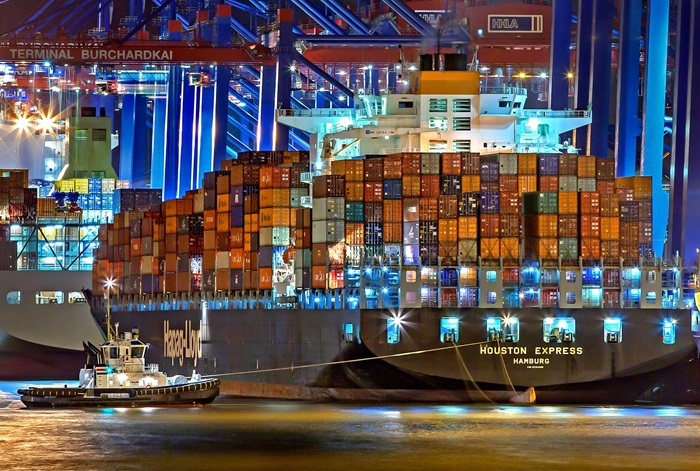1. The UK’s Ascent to Becoming the World’s Fourth Largest Exporter
In a remarkable testament to the resilience and adaptability of the UK’s economy, recent data reveals a significant shift in the global trade landscape. The United Kingdom, traditionally known for its strength in manufacturing and goods export, has seen a surge in its services trade, catapulting it to the position of the world’s fourth-largest exporter. This article delves into the factors contributing to this shift, the implications for the UK’s economy, and the potential future of global trade dynamics.
Key sectors driving UK services trade
The key sectors driving the UK’s services trade are diverse and span across various industries. Here are some of the significant contributors:
1. Digital Sector:
The digital sector, which includes IT, software, and computer services, has been a major contributor to the UK’s services exports.
2. Creative Industries:
This sector, which encompasses film, TV, video, radio, and music, has also made substantial contributions to the value of goods and services imported and exported.
3. Professional and Business Services:
Combined with financial services, these sectors account for a significant portion of UK services exports.
4. Financial Services:
The financial services industry, excluding insurance and pension funding, was the largest exporter and importer of services.
5. Other Sectors:
Cross-border trade takes place in many more areas, from tourism and travel, transportation by road, sea, air and rail, telecoms and IT, to broadcasting, film, culture, (higher) education, construction, and retail.
These sectors have shown remarkable resilience and adaptability, contributing significantly to the UK’s position as the world’s fourth-largest exporter of services. It’s important to note that the specific contributions of each sector can vary year by year and are influenced by various factors, including economic conditions, technological advancements, and policy changes.
2. India’s Economic Leap: The $100 Billion FDI Boost from European FTA

Credit Jose Aragones via Pexels
In an unprecedented economic development, India has recently witnessed a massive surge in Foreign Direct Investment (FDI), receiving a boost of $100 billion. This monumental increase is largely attributed to the newly established Free Trade Agreement (FTA) with Europe. This article delves into the intricacies of this economic milestone, exploring its implications for India’s growth trajectory and the potential opportunities it presents for both domestic and foreign investors.
Statistics
Key statistics and details about the FDI boost in India:
- The European Free Trade Association (EFTA), which consists of Switzerland, Norway, Iceland, and Liechtenstein, will invest $100 billion in India over a 15-year period.
- The first $50 billion should be invested within 10 years of the Trade & Economic Partnership Agreement (TEPA) coming into force (expected in early 2025), and the next $50 billion in the five years thereafter.
- The agreement aims to generate 1 million jobs in India over the same timeframe.
- The four TEPA countries have announced $20.3 billion in greenfield FDI in India since records began in 2003.
- The biggest sector recipients have been building materials, metals, industrial equipment, and food and beverages.
- The agreement follows a record year for FDI in the world’s fastest-growing large economy. Data from fDi Markets shows that India recorded $85.2 billion-worth of capital expenditure commitments across 1009 projects, beating previous records for project numbers and values.
- Under TEPA’s trade provisions, both parties will eliminate customs duties on fish plus most industrial goods including pharmaceuticals, machinery, watches, fertilizers, chemical products, and minerals.
This FDI boost is expected to bring significant economic benefits to India, such as better integrated and more resilient supply chains, new opportunities for businesses and individuals, increased trade and investment flows, job creation, and economic growth.
3. A New Era of Bioenergy: Fibenol’s €700 Million Biorefinery in Latvia

Credit Boris Ulzibat Pexels
In a significant development for the bioenergy sector, Fibenol, a leading player in the industry, has announced plans to invest a staggering €700 million in a biorefinery in Latvia. This investment marks one of the largest in the country’s industrial sector and is set to revolutionize its bioenergy landscape. This article will delve into the details of this investment, exploring its potential impact on Latvia’s economy, the bioenergy industry, and the broader implications for renewable energy in Europe.
Timeline
The timeline for Fibenol’s investment in the biorefinery in Latvia is as follows:
- On March 15, 2024, a Memorandum of Understanding was signed between the Estonian company Fibenol OÜ and the Ministries of Economy, Finance, Agriculture, Climate and Energy, and the Investment and Development Agency of Latvia (LIAA) on the implementation of an investment project with a total investment volume of 600 to 700 million euros.
- The first commercial-scale biorefinery is the next goal for Fibenol following the completion of their demo plant commissioning.
- The total investment in the demo plant has now reached around €70 million, of which the European Union contributed almost €20 million by various research and development projects.
Products
The biorefinery in Latvia, backed by Fibenol, will produce a range of bio-based raw materials. Here are some key products:
- Lignin: Fibenol’s extrusion-based lignin, trademarked as LIGNOVA™, can be used directly or processed further into biochemicals, coatings and adhesives, resins, and much more.
- Wood Sugars: These are valuable for various industrial applications.
- Specialty Cellulose: This is another high-value material derived from woody biomass.
These products are the result of Fibenol’s innovative fractionation process, which converts more than 90% of woody biomass into high-value materials with minimal environmental impact. The biorefinery will leverage Fibenol’s patented and market-ready technology, the Sunburst pretreatment technology. This technology facilitates the wood fractionation process, enabling the conversion of more than 90% of the feedstock into functional biomaterials that can replace fossil chemicals in the chemical and materials industries. This investment is a significant step towards a more sustainable and circular bioeconomy.
4. GE Aerospace Fuels Indian Aerospace Industry with $30 Million Investment in Pune Facility

In a significant development that underscores the growing prominence of India in the global aerospace industry, GE Aerospace, a world leader in aviation, power, and renewable energy, has announced plans to expand its manufacturing operations in Pune, India. This strategic move not only reinforces GE Aerospace’s commitment to investing in the region but also highlights the potential of Pune to emerge as a key hub in the aerospace manufacturing sector. The expansion is expected to bring a multitude of benefits, including technological advancements, job creation, and a boost to the local economy. This article delves into the details of this expansion and explores its implications for the future of aerospace manufacturing in India.
Challenges
Expanding aerospace manufacturing operations in a new region like Pune, India, can present several challenges for GE Aerospace. Here are some potential challenges they might face:
1. Technology Gaps:
The aerospace industry is highly technology-driven. There might be gaps in the availability of advanced technologies needed for aerospace manufacturing.
2. Regulatory Hurdles:
Navigating the regulatory landscape for aerospace manufacturing in India could be challenging. This includes understanding and complying with local laws, regulations, and standards.
3. High Dependency on Imports:
For sophisticated weapons systems and certain high-tech components, there might be a high dependency on imports.
4. Budgetary Constraints:
Expansion projects often face budgetary constraints, which could impact the pace or scope of expansion.
5. Access to Technology and Funding:
Securing access to cutting-edge technology and adequate funding can be challenging.
6. Availability and Cost of Raw Materials:
The availability of necessary raw materials and their cost can also pose a challenge.
7. Certification Processes:
Adhering to and obtaining necessary certifications can be a time-consuming and complex process.
These challenges are not insurmountable and can be addressed with careful planning, strategic partnerships, and support from local government and industry bodies. The Indian government’s focus on domestic manufacturing and technological upgrades are steps towards addressing these challenges.
5. Global Seamless Invests $35 Million in First U.S. Facility in Louisiana

Global Seamless Tubes & Pipes, a leading manufacturer and exporter of carbon, alloy, and stainless steel cold-drawn and hot-finish seamless tubes and pipes, has announced a significant investment of $35 million to establish its first U.S. production facility.
Expanding Horizons
The India-based company has chosen Mansfield, Louisiana, for its first production facility in the Western Hemisphere. This strategic move is expected to create 135 direct jobs and an additional 251 indirect jobs.
Advanced Manufacturing
The new facility will house advanced machinery that integrates both hot finishing and cold-drawn manufacturing processes in the same unit. This innovative approach positions the company to better meet growing demand and build a domestic supply chain for North American customers in engineering, oil and gas, and power generation sectors.
A Boost for the Local Economy
The investment is a significant boost for the local economy. “LED is dedicated to bringing jobs and economic opportunities to each and every corner of our state,” said LED Secretary Susan B. Bourgeois. The project is expected to breathe new life into the former Hensley Industries facility located in Mansfield.
Looking Ahead
Commercial operations at the new facility are scheduled to start by the end of 2024. As Global Seamless expands its global footprint, the company continues to demonstrate its commitment to providing high-quality services and products to its customers.
6. TSMC’s $11.6 Billion Gamble: A New Dawn for the Global Semiconductor Industry

In a groundbreaking development that promises to reshape the landscape of the global semiconductor industry, Taiwan Semiconductor Manufacturing Company (TSMC), the world’s largest dedicated independent semiconductor foundry, has announced plans to establish its third facility in Arizona. This ambitious expansion comes on the heels of securing a staggering $11.6 billion in funding. The move not only underscores TSMC’s commitment to bolstering its manufacturing capabilities but also signals a significant boost to Arizona’s economy and the U.S. tech industry at large.
Impact
TSMC’s new facility in Arizona is expected to have a significant impact on the global semiconductor market. Here are some potential effects:
1. Boost to US Semiconductor Industry:
The new facility marks a significant step in the Biden administration’s efforts to attract computer chip production back to the US. This could lead to a resurgence in the US semiconductor industry, which has seen much of its manufacturing migrate to Asia over the past few decades.
2. Advanced Chip Production:
TSMC plans to start producing state-of-the-art two-nanometre chips at the new factory by 2028. These advanced chips underpin all artificial intelligence and are crucial to many sectors, from consumer electronics to defence.
3. Increased Global Supply Resilience:
With TSMC’s expansion outside of Taiwan, the global economy’s reliance on Taiwan for advanced semiconductors could be reduced. This could enhance the resilience of the global chip supply chain.
4. Promotion of the Foundry Model:
TSMC’s success has been largely due to its foundry model, where semiconductor fabrication is separated from design. This model allows many companies to access advanced manufacturing facilities without investing billions of dollars. TSMC’s expansion could further promote this model, potentially leading to more innovation in chip design.
5. Potential Impact on Other Markets:
The new facility could also influence other markets. For instance, TSMC’s first chip manufacturing facility in Japan has been predicted to revitalize Japan’s once-dominant chipmaking sector.
It’s important to note that these are potential impacts and the actual effects will depend on various factors, including market dynamics, technological advancements, and geopolitical considerations. The semiconductor industry is complex and rapidly evolving, making it a fascinating area to watch in the coming years.
7. The Dawn of a New Era: Philadelphia and Japan’s Free Trade Agreement

Jayson Gomes via Pexels
In the ever-evolving global economic landscape, the recent Free Trade Agreement (FTA) between Philadelphia and Japan marks a significant milestone. This article delves into the intricacies of this landmark agreement, exploring its implications for both Philadelphia, the ‘City of Brotherly Love’, and Japan, the ‘Land of the Rising Sun’.
The FTA, a testament to the enduring spirit of international cooperation, promises to usher in a new era of economic prosperity and cultural exchange. It stands as a beacon of hope amidst the tumultuous waves of global trade disputes, demonstrating the power of diplomacy and mutual respect.
As we navigate through the details of this agreement, we will uncover the potential benefits and challenges that lie ahead for both parties. From the bustling streets of Philadelphia to the vibrant markets of Tokyo, the impact of this agreement will resonate, transforming the economic fabric of these two regions and potentially, the world.
Affected industries
The Free Trade Agreement (FTA) between Philadelphia and Japan is likely to have a significant impact on several key industries. While the specific details of this agreement are not available, we can draw parallels from similar agreements between countries. For instance, the UK-Japan trade deal had significant implications for the following sectors:
- Manufacturing: The agreement secured new wins for British businesses in the manufacturing industry. It also eliminated duties on 21 industrial goods.
- Food and Drink: Lower Japanese tariffs on some agricultural products, including pork, beef, and salmon, were part of the deal. This could potentially benefit Philadelphia’s food and drink industry.
- Tech Industries: The deal went far beyond the existing EU deal, securing new benefits for the tech industry.
- Financial Services: The openness of services markets, particularly financial services, was ensured.
- Digital and Data: The deal had big benefits for digital and data, which could potentially benefit Philadelphia’s burgeoning tech sector.
8. Blossoming Opportunities: The Impact of UK’s Tariff Suspension on East Africa’s Flower Industry

Johnmark Smith via Pexels
In a vibrant display of international trade dynamics, the business landscape in East Africa is experiencing a significant upturn. The catalyst? The United Kingdom’s recent decision to suspend tariffs on flower exports from this region. This move has not only invigorated the floriculture industry but also painted a promising picture for the overall economic growth in East Africa. In this article, we delve into the implications of this policy change and explore how it’s causing businesses to bloom in East Africa.
The suspension of the UK’s Global Tariff is primarily focused on the cut flower industry. However, the impact of this decision could potentially extend to other sectors indirectly. Here’s how:
- Transportation and Logistics: The tariff suspension allows unlimited quantities of flowers to enter the UK duty-free, even if they transit through a third country. This could boost the logistics and transportation sector, which plays a crucial role in shipping these products.
- Employment: The tariff-free access to the UK market means that East African flower producers can increase production without the concern of additional export costs. This could lead to an increase in employment in the floriculture industry.
- Investment: The new access to a larger, tariff-free market in the UK is expected to encourage both existing businesses and new entrants to expand operations. This could attract more investment into East Africa, benefiting various sectors.
- Consumer Market: The decision will offer British consumers a wider variety of flowers at potentially lower prices. This could stimulate consumer spending and have a positive impact on the retail sector.
Please note that while these are potential benefits, the actual impact would depend on various factors and market dynamics. It would be interesting to observe how this policy change unfolds in the coming years.
9. WTO Forecasts Rebound in Global Trade but Warns of Downside Risks

Julius Silver via Pexels
In a new forecast released on April 10, 2024, the World Trade Organization (WTO) predicts a gradual recovery in global goods trade after a contraction in 2023. The decline in 2023 was primarily driven by the lingering effects of high energy prices and inflation. However, while the outlook is positive, there are significant downside risks that warrant attention.
Key Points:
1. Trade Rebound:
The volume of world merchandise trade is expected to increase by 2.6% in 2024 and 3.3% in 2025, following a 1.2% decline in 2023. This recovery is attributed to resilient supply chains and a solid multilateral trading framework.
2. Lingering Risks:
Despite the positive trajectory, several challenges remain:
- Regional Conflicts: Ongoing conflicts in various regions could disrupt trade flows.
- Geopolitical Tensions: Heightened tensions between nations may impact trade relations.
- Economic Policy Uncertainty: Unclear policy directions could hinder investment and trade decisions.
3. Inflationary Pressures:
The report highlights that inflationary pressures are expected to abate in 2024, allowing real incomes to grow, particularly in advanced economies. This, in turn, should boost consumption of manufactured goods.
4. Services vs. Goods:
While goods trade faced a decline, commercial services exports showed resilience, offsetting some of the losses.
5. Global GDP Growth:
The report estimates stable global GDP growth at market exchange rates, with rates of 2.6% in 2024 and 2.7% in 2025. The contrast between GDP growth and merchandise trade volume is linked to inflation’s impact on consumption patterns.
Director-General’s Perspective:
WTO Director-General Ngozi Okonjo-Iweala emphasized the importance of mitigating risks to maintain economic growth and stability. She highlighted the role of resilient supply chains and a strong multilateral trading framework in supporting livelihoods and welfare.
As we navigate the path to recovery, it remains imperative to address geopolitical strife and trade fragmentation. The world’s economic well-being hinges on our ability to strike a balance between growth and risk management.
Featured image Pexels






